What is Aquaponics, you ask?
According to the book we followed, which was very informative, called Aquaponic Gardnening by Sylvia Bernstein, “Aquaponics is the cultivation of fish and plants together in a constructed, recirculating ecosystem utilizing natural bacterial cycles to convert fish waste to plant nutrients. This is an environmentally friendly, natural food growing, method that harneses the best attributes of aquaculture and hydroponics without the need to discard any water to filtrate or add fertilizers.”
In short, you have a tank of fish that has a pump that sucks the water from the tank (with the fish poops) and pushes it into the growbeds (which are filled with inoculated gravel or hydroton) to feed and water the plants. Then, the plants filter the water and it slowly drains back down into the fish tank.
In 2012, after moving back into our home after it was rebuilt, we jumped right onto our first project of building an aquaponics system. With the help of Rob Nash @ Hanna Leigh Farms and Brite Ideas in Austin, we were able to view systems, ask questions, and finally develop our own floor/flow plan! To help with energy costs, we decided to design and Ebb and Flow system. Putting it together, taking it apart, and putting it back together again=a long night! We designed 2 4ft x 8ft beds which were 12 inches high, and purchased a 300 gallon water trough from Tractor Supply. Next came the piping, which we bought from Home Depot. We wanted everything new, so it was costly! But if you know what you are doing, you can use refurbished materials to make it much cheaper! Unfortunately, there were not many videos or blogs on how to do any of this stuff so I hope this post will give some of you a little direction! We used way too many screws to put our beds together! It was VERY HEAVY! SO we took some out when we rebuilt it, realizing we did not need that many. We were just scared the water that would be going into the grow bed would be so heavy that it would cause the whole thing to burst open! We were total amateurs I know :).
The book mentioned above gives great references for calculating the amount of water, what size pump you need, what type of system you want, the PH levels you need, lighting, etc. It is an amazing help!! We decided to put our system in our garage so it would be close and we could monitor it. Also, we were scared our fish would die if it were outside in the winter. My advice, put it in a hoophouse or greenhouse of a sort. We have terrible field mice so they were always coming in to get our goodies! So, after we built the beds, lined them with pond liner, bought the tank, started the seedlings, hung the fluorescent lighting, filled the tank with water, added Air Stones to the tank, filled the grow beds with hydroton (volcanic rock you can find on amazon for a small bed or find a hyroponics store, CAUTION it is expensive but considered the Cadillac of growing media), and assured the plumbing worked correctly, we were ready to prime the system. This means putting the bacteria in the system and boosting your nitrification cycle, before you even think about adding your fishies! Teaming with Microbes is another great book for understanding this part of the system. We went to Brite ideas in Austin and they gave us a 5 gallon bucket of compost tea they brewed, Mr. Nash gave us some Red Wrigglers (you can buy this online, which we ordered 1000 from Uncle Jim’s Worm Farm online and divided in half. 500 for each growbed), and we added all of this to the system and let it run on a normal schedule, “The Cycling Process” (45 minute off, 15 minute on Cycle) until the Ammonia had cleared up and we began seeing Nitrates present in the system. This is called the Nitrification process (again, the Aquaponic Gardening book is a great reference).
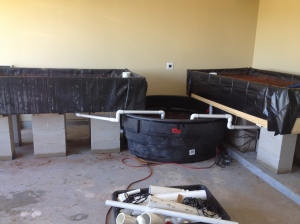



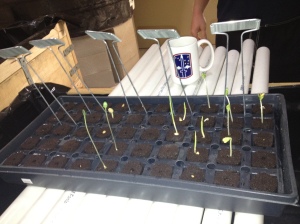
Finally, we were ready for FISH and PLANTS! You have to have good timing on this because the plants are what filters the water for it to be a healthy level for the fish to stay in. You also need the fish poop to grow the plants. So put your plants in when they are a decent size, and have enough to fill your growbeds. Sylvia Bernstein talks big on ratios on this part. Ratio for water, fish, and plants. We found a guy who sold Tilapia and Catfish for us to purchase a couple of hours away, so we headed out!
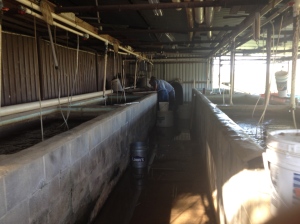
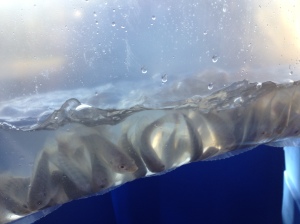
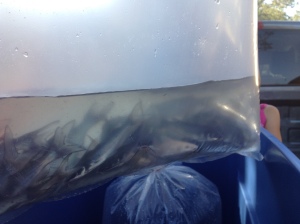
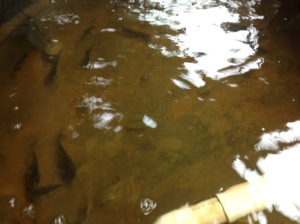
What a great day it was to have fish in our tanks! Let the poop shooting begin!
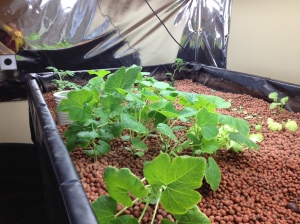
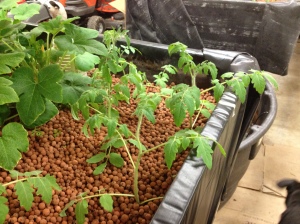
In the pic above, you can see we added mylar to the walls to prmote sunlight. We also added suntubes in the garage to help wit hnatural ligthing. We thought that is all we would need, but it proved to not be enough, hence the fluorescent lights hanging as well.
Later on…
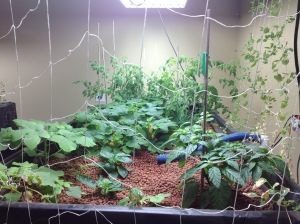
My husband and I are NOT scientists, or mathematical geniuses! This was all completed by trial and error, the API water test kit (found at fish stores), and lots of research!
I wrote the article, but my husband is the real genius behind all of this. He spent hours researching, reading, talking with AP System owners, looking at blogs, and being the most amazing person I have ever seen! Going from Grunt Infantry in the US Army, to building this beautiful masterpiece and sustaining it, is really an amazing feat! We are available to answer questions so please do!
We did take our system down a few months ago. Our plan is to build a hoop house outside for this baby! Now that we know what we are doing in AP systems, it should not be so difficult…building the hoop house however is a new venture we will document! Until then… stay sustainable!

Leave us a message!